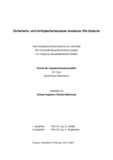Citation link:
https://nbn-resolving.org/urn:nbn:de:hbz:467-1805Files in This Item:
| File | Description | Size | Format | |
|---|---|---|---|---|
| mahmoud.pdf | 1.56 MB | Adobe PDF |  View/Open |
| Dokument Type: | Doctoral Thesis | metadata.dc.title: | Sicherheits- und Verfügbarkeitsanalyse komplexer Kfz-Systeme | Other Titles: | Safety- and availability-analysis of complex automotive systems | Authors: | Mahmoud, Rachad | Institute: | Fachbereich 12, Elektrotechnik und Informatik | Free keywords: | Sicherheitsanalyse, Verfügbarkeit, Kraftfahrzeugelektronik | Dewey Decimal Classification: | 620 Ingenieurwissenschaften und Maschinenbau | GHBS-Clases: | ZQS | Issue Date: | 2000 | Publish Date: | 2006 | Abstract: | In der vorliegenden Arbeit wird eine Methodik zur geschlossenen Bewertung der F ehlerhäufigkeit, V erfügbarkeit, S icherheit und W irtschaftlichkeit (F/V/S/W) komplexer sicherheitsrelevanter Kfz-Systeme entwickelt und anhand von Beispielen veranschaulicht. Diese Methodik fußt auf einer Fusion von Fehlerbäumen und Markov-Ketten zu hierarchischen Modellen. Die hierarchische Modellierung erlaubt es, sowohl eine qualitative wie auch quantitative Systemaussage mit vertretbarem Analyseaufwand zu generieren. Modifikationen innerhalb des Entwicklungsstandes können mit geringem Aufwand in die Systembetrachtungen integriert werden. Um die Leistungsfähigkeit der hierarchischen Modellierung zu verifizieren, wurde das noch im Forschungsstadium befindliche Fahrdynamikstabilisierungssystem D rive- b y- W ire (D-b-W) auf seine F/V/S/W hin untersucht. Wie sich zeigte, erwiesen sich Fehler der Raddrehzahlsensorik als kritischer Pfad hinsichtlich der Sicherheit des Systems. Aus diesem Grund wurden Redundanzkonzepte entwickelt, die zur Toleranz gegen obige kritischen Fehler führen. Abschließend wurden die Auswirkungen der verschiedenen Redundanzkonzepte auf die Fehlerhäufigkeit, Verfügbarkeit, Sicherheit und Wirtschaftlichkeit des Systems D-b-W mittels der hierarchischen Modellierung bewertet. In the dissertation-thesis in hand a methodology is developed, which allows to determine the failure-probability, availability, safety and economy of complex safety-relevant automotive systems in a closed model. This methodology is based on the fusion of fault-trees and Markov-chains to a hierarchical model. The hierarchical modelling generates a qualitative as well as quantitative prediction of the above mentioned system-quality-parameters. Modifications during the development-process of a complex system can be integrated in the analysis with small effort. In order to demonstrate the potentials of the hierarchical modelling, it was applied to determine the failure-probability, availability, safety and economy of a driving-stability-control-system. This system, which is called Drive-by-Wire was in the early research-phase, when the first safety and availability-analysis had been performed. As it turned-out, failures of the wheel-speed-sensors are mainly responsible for the unsafety of this system. Therefore redundancy concepts were developed which yield tolerance against above mentioned critical failures. Finally the influence of different redundancy concepts on the failure-probability, availability, safety and economy of Drive-by-Wire was determined by the hierarchical modelling. |
URN: | urn:nbn:de:hbz:467-1805 | URI: | https://dspace.ub.uni-siegen.de/handle/ubsi/180 | License: | https://dspace.ub.uni-siegen.de/static/license.txt |
| Appears in Collections: | Hochschulschriften |
This item is protected by original copyright |
Page view(s)
479
checked on Nov 30, 2024
Download(s)
262
checked on Nov 30, 2024
Google ScholarTM
Check
Items in DSpace are protected by copyright, with all rights reserved, unless otherwise indicated.

